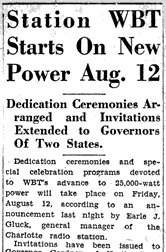


![]()
![]()
Dedication ceremonies and special celebration programs devoted to WBT's advance to 25,000-watt power will take place on Friday, August 12, according to an announcement last night by Earle J. Gluck, general manager of the Charlotte radio station.
Invitations have been issued to Governor Gardner of North Carolina and Governor Blackwood of South Carolina, to attend the services and make the dedication addresses, which will take place at 7 P. M., at the site of the WBT transmitter building, located eight miles south of Charlotte, on the Nation's Ford road. The complete orchestra of the station will supply the music for the occasion.
A unique feature of the occasion will be the throwing of the switch which will transfer the WBT power from the 5,000 watts now being used, to 25,000 watts.
Continue Through Night.
The celebration programs will continue through the entire night of August 12, until 7 A. M., on the following day. Shortly after the conclusion of the dedication at the transmitter, a half hour gala program will originate in the WBT studios in the Wilder building to be broadcast over the Dixie network, as well as over WBT.
Clarence Kuester, secretary of the Charlotte chamber of commerce, and Mayor Charles Lambeth, promise to be speakers during the course of the evening.
Discussing the effect of the increase in power for the station, Mr. Gluck said:
"Various questions have arisen recently on the probable result of the step up to high power by this station, from both the angle of receiving sets as well as programs, and while it is not possible to definitely predict exact effects, past experience on increases in power both on this and other stations form a sound basis for determining approximate differences.
"In the area from ten to a hundred miles from Charlotte or even further there are numerous places where interference is noted in receiving WBT, either from static causes or other stations."
Increase Signals.
"The new power will increase the delivered signal of WBT's broadcasts approximately two and two-tenths times; in other words it will be heard more than twice as loud as it was before. Since the volume control on a receiver will be turned to the point of comfortable reception, the actual effect will be the marked reduction or entire elimination of static or station interference. The ability of the radio signal to override static and other interference is one of the advantages of high power to the radio audience.
"No amount of power will reduce the peculiarity known as fading, a condition that sets in at a distance of sixty to eighty miles from the transmitter. However, there is one benefit which increased power will give to those living in areas subject to fading, provided they use modern radio receivers incorporating automatic volume control; the majority of the time there will be sufficient signal strength to actuate the receiver and the automatic volume control will maintain the reception at fairly consistent levels. The area inside the sixty to eighty mile point will, of course, be covered with a strong signal at all times.
"While listeners residing within a ten mile range of the transmitter will notice the same increase in volume as at other points, all modern receivers will 'tune as sharply' as at present.
"Doubtless a comparatively few old sets will show slightly greater difficulty in tuning away from WBT, just as they do at present. This is a 'receiver problem,' however, for no matter what the increase in power, with modern, perfected equipment such as WBT is installing, the broadcast wave will occupy no wider space in the ether than that of a low powered station.
"It is entirely practicable to operate a modern receiving set close by the transmitting antennae and tune in other stations without difficulty.
"Stringent regulations covering the location of high power radio stations are strictly enforced by the Federal Radio commission. It is only after their engineers are fully satisfied that the station is located sufficiently distant from populated areas not to cause interference to any but obsolete receivers. that permission is granted for the erection of high power apparatus."